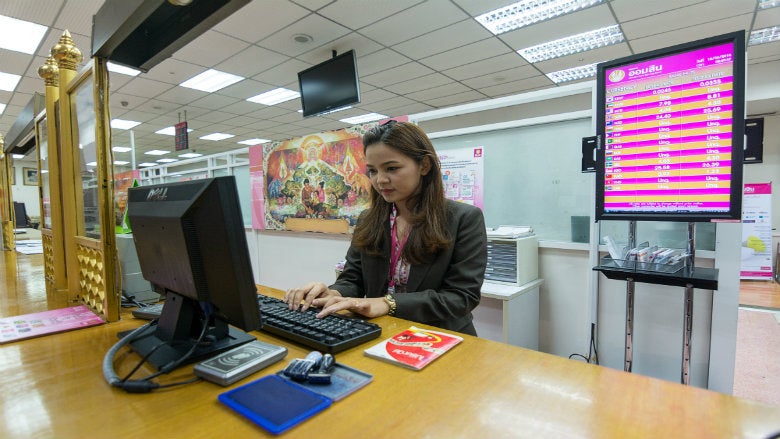
มีโอกาสสูงที่คุณทำงานอยู่ในภาคบริการ ประเทศไทยมีงานในภาคบริการถึง 17 ล้านตำแหน่งหรือร้อยละ 40 ของกำลังแรงงานไทย ภาคบริการครอบคลุมหลายอุตสาหกรรมทั้ง การท่องเที่ยว การค้าปลีก สุขภาพ การสื่อสาร การขนส่ง รวมถึงวิชาชีพที่เป็นที่ต้องการ อาทิ สถาปนิก วิศวกร นักกฎหมาย และแพทย์ พ่อแม่หลายคนหวังว่าลูกจะสามารถเข้าทำงานในภาคบริการซึ่งเป็นภาคที่ประเทศไทยได้ฝากความหวังด้านเศรษฐกิจและความมุ่งมั่นที่จะก้าวไปสู่ประเทศที่มีรายได้สูงไว้
อุตสาหกรรมที่จะมีความสำคัญในอนาคต เช่น การแพทย์ การท่องเที่ยวเชิงส่งเสริมสุขภาพ รวมถึงโลจิสติกส์ และการบินต่างก็อยู่ในภาคบริการ ในขณะที่อุตสาหกรรมอื่นๆ อาทิ หุ่นยนต์ อาหารสำหรับอนาคต และ อิเล็กทรอนิกส์อัจฉริยะก็ล้วนแต่ต้องพึ่งพางานจากภาคบริการ การบริการการศึกษาก็ให้บริการการฝึกอบรมและทักษะที่จำเป็นสำหรับเศรษฐกิจสมัยใหม่และนวัตกรรม
ทำไมภาคบริการจึงมีความสำคัญกับเศรษฐกิจไทย? ภาคบริการมีพลวัตและการเติบโตซึ่งสามารถขับเคลื่อนเศรษฐกิจไทยได้ ประเทศที่พัฒนาแล้ว อาทิ สหรัฐอเมริกา และประเทศในทวีปยุโรปต่างขับเคลื่อนเศรษฐกิจด้วยภาคบริการซึ่งมีมูลค่าถึงร้อยละ 70-80 ของจีดีพี มูลค่าสินค้าจากภาคการผลิตส่วนใหญ่ก็มาจากภาคบริการไม่ใช่จากการผลิต ตัวอย่างเช่น สองในสามของมูลค่าสมาร์ทโฟน อาทิ แอปเปิ้ลไอโฟน หรือ โนเกีย N95 ล้วนเกิดจากการสนับสนุนจากภาคบริการ อันได้แก่ ลิขสิทธิ์ การค้าปลีก การกระจายสินค้า และกำไรจากการปฏิบัติการ ส่วนการประกอบมีมูลค่าน้อยกว่าร้อยละ 10 ของมูลค่าสินค้าทั้งหมด นอกจากนี้ ภาคบริการยังเพิ่มมูลค่าสินทรัพย์ไม่มีตัวตนสุทธิให้กับแจ๊กเกตที่ผลิตในประเทศจีนและนำไปขายที่สหรัฐอเมริกาในรูปของลิขสิทธิ์ทรัพย์สินทางปัญญา และผลกำไร ในขณะที่ประเทศกำลังพัฒนาในภูมิภาคเอเชียเป็นผู้ผลิตและผู้ประกอบชิ้นส่วนรายใหญ่ของโลกนั้น หากแต่ผลกำไรส่วนใหญ่กลับไปตกอยู่ในมือของภาคบริการในประเทศที่พัฒนาแล้ว
ภาคบริการของไทยเป็นอย่างไร? ภาคบริการของไทยมีสัดส่วนคงที่ประมาณร้อยละ 50 ในช่วงสองทศวรรษที่ผ่านมา ส่วนใหญ่เป็นอุตสาหกรรมที่มีผลิตภาพต่ำซึ่งจ้างงานแรงงานทักษะต่ำ และมีสัดส่วนในภาคการส่งออกต่ำโดยส่วนใหญ่เป็นภาคบริการแบบพื้นฐานทั่วๆ ไป ภาคบริการในประเทศไทยยังไม่ได้เพิ่มสัดส่วนมากขึ้นอย่างยั่งยืนเหมือนในประเทศที่มีลักษณะคล้ายกันอื่นๆ ในกลุ่มอาเซียนหรือนอกกลุ่มอาเซียน รวมถึงประเทศที่พัฒนาแล้ว ตัวอย่างเช่น ภาคบริการของจีนกำลังเพิ่มสัดส่วนในจีดีพีอย่างรวดเร็ว และกำลังจะไล่ตามประเทศไทยทัน
ทำอย่างไรประเทศไทยจะใช้ศักยภาพของภาคบริการได้เต็มที่? หากดูจากตัวอย่างประเทศเพื่อนบ้านในกลุ่มอาเซียนพบว่าการผสานความริเริ่มจากภาคเอกชนและการสนับสนุนจากภาครัฐจะช่วยให้เกิดธุรกิจ และการติดตามมาตรฐานคุณภาพจะช่วยเพิ่มผลผลิตและการส่งออกของภาคบริการ ตัวอย่างเช่น ภาคบริการการเงินในสิงคโปร์ การอุดมศึกษาในมาเลเซีย การบริการสุขภาพในไทย และการให้บริการเกี่ยวกับด้านโทรคมนาคมในฟิลิปปินส์
สำหรับประเทศไทย การสนับสนุนด้านกฏระเบียบแวดล้อมเพื่อความสะดวกในการประกอบธุรกิจ การลดข้อจำกัดทางนโยบายทั้งในและระหว่างประเทศ การเปิดแข่งขัน และการรวมตัวทางการค้า อาทิ การดำเนินการตามข้อตกลงประชาคมเศรษฐกิจอาเซียนจะเป็นปัจจัยสำคัญที่จะผลักดันให้ผลิตภาพเติบโตขึ้น รวมถึงนวัตกรรมใหม่ๆ ในภาคบริการ นอกจากนี้ การให้ความสำคัญในเรื่องทักษะที่ยังขาดแคลน และทำให้การศึกษามีคุณภาพสำหรับประชาชนทุกคนต่างก็เป็นประเด็นสำคัญที่จะช่วยสร้างความพร้อมให้แรงงานไทย
รายงานของธนาคารโลกพบว่าประเทศไทยมีกฏระเบียบในภาคบริการมากกว่าค่าเฉลี่ยเมื่อเทียบกับประเทศอื่นๆ ในกลุ่มอาเซียน หรือในภูมิภาคอื่นๆ ของโลก โดยเฉพาะในภาคบริการวิชาชีพ อาทิ การบัญชี กฎหมาย สถาปัตยกรรม วิศวกรรม และการให้คำปรึกษาด้านการบริหาร ตัวอย่างเช่น ทันตแพทย์จากฟิลิปปินส์จะต้องสอบผ่านข้อสอบที่เป็นภาษาไทยจึงจะสามารถทำงานที่ไทยได้
ในขณะที่ประเทศไทยได้เก็บเกี่ยวผลประโยชน์จากการเปิดเสรีทางการค้าในอดีตทั้งจากภาคการผลิต การค้าขายสินค้า และการนำเข้าสินค้าทุนที่ต้องเสียภาษีศุลกากรซึ่งอัตราลดลงจากร้อยละ 40 ในช่วงปีพ.ศ. 2523-2532 (ยุค ค.ศ. 1980s) เหลือร้อยละ 9 ในปีพ.ศ. 2549 แต่การเปิดการค้าเสรีไม่ได้คลอบคลุมไปถึงภาคบริการ นอกจากนี้ หน่วยงานที่ให้บริการ รัฐวิสาหกิจ และอุตสาหกรรมที่ให้บริการในประเทศหลายหน่วยงานต่างก็ได้รับการคุ้มครองจากการเปิดแข่งขัน อาทิ การมีข้อจำกัดที่เข้มงวดต่อการเข้ามาลงทุนและการให้บริการจากบริษัทต่างชาติ การให้บริการด้านการศึกษาและสุขภาพนั้นต้องเป็นบริษัทที่คนไทยถือหุ้นส่วนใหญ่ ในภาคการให้บริการทางการเงินนั้นมีความก้าวหน้าในการเปิดให้บริการทางการเงินแต่ยังมีข้อจำกัดด้านกฎหมาย
เศรษฐกิจของประเทศไทยคาดว่าจะเติบโตได้ถึงร้อยละ 3.1 ในปีพ.ศ. 2559 และเติบโตร้อยละ 3.2 ในปีพ.ศ. 2560 ซึ่งเติบโตกว่าร้อยละ 2.8 เมื่อปีที่ผ่านมา แม้ว่าจะมีความท้าทายจากปัจจัยภายนอกอันเนื่องมาจากแนวโน้มความไม่แน่นอนของเศรษฐกิจโลก อย่างไรก็ดี ประเทศไทยยังมุ่งมั่นที่จะปฏิรูปโครงสร้างอย่างต่อเนื่องซึ่งจะเปิดโอกาสให้ภาคบริการได้แสดงศักยภาพอย่างเต็มที่อันจะช่วยให้เศรษฐกิจไทยเดินสู่เส้นทางการเติบโตมากกว่าร้อยละ 4 ต่อปีในระยะยาว ปัจจัยเหล่านี้จะส่งผลให้ประเทศไทยก้าวจากประเทศที่มีรายได้ปานกลางไปสู่ประเทศที่มีรายได้สูงในที่สุด เศรษฐกิจของไทยกำลังก้าวอยู่บนเส้นทางการฟื้นฟูและการสร้างความเข้มแข็งให้กับภาคบริการอันจะช่วยให้เกิดงานที่ดีใหม่ๆ มีรายได้สูงขึ้น และสร้างโอกาสให้กับคนไทยทุกคน ใครจะรู้ว่า บางทีคุณก็อาจจะมีโอกาสเป็น แจ๊ค มา หรือ โทนี เฟอร์นานเดส ของไทยได้เช่นกัน
บล็อกนี้เขียนขึ้นจากข้อมูลที่ได้จาก รายงานตามติดเศรษฐกิจไทย ฉบับเดือน ธันวาคม 2559 โดยธนาคารโลก และได้ตีพิมพ์เป็นบทความลงหนังสือพิมพ์ บางกอกโพสต์


Join the Conversation